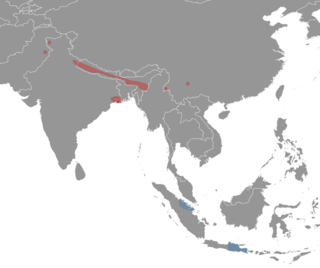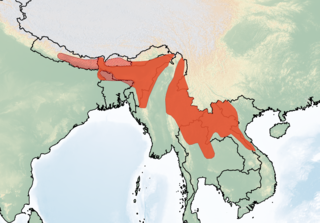The Ethiopian striped mouse or striped-back mouse is a species of rodent in the family Muridae. It is only found in Ethiopia. It was formerly classified in the monotypic genus Muriculus, but phylogenetic evidence supports Muriculus being a subgenus within Mus, the true mice. The Ethiopian striped mouse's natural habitats are subtropical or tropical high-altitude grassland and urban areas. It is threatened by habitat loss.
Baoule's mouse is a species of rodent in the family Muridae. It is found in Benin, Ivory Coast, Guinea, possibly Ghana, and possibly Sierra Leone. Its natural habitat is dry savanna.

The fawn-colored mouse is a species of rodent in the family Muridae. It is found in Cambodia, India, Indonesia, Laos, Myanmar, Nepal, Thailand, and Vietnam.

Cook's mouse is a species of rodent in the family Muridae. It is found in southern and south-eastern Asia from India to Vietnam.
The Gounda mouse is a species of rodent in the family Muridae. It is found only in Central African Republic, around the Gounda River. Its natural habitat is moist savanna.
The Hausa mouse is a species of rodent in the family Muridae. It is found in Benin, Burkina Faso, Ivory Coast, Ghana, Mali, Mauritania, Niger, Nigeria, and Senegal. Its natural habitats are dry savanna, arable land, rural gardens, and urban areas.

Matthey's mouse is a species of rodent in the family Muridae. Matthey's mouse was first described by Francis Petter (1923–2012) in 1969 and was named after Robert Matthey (1900–1982).
The Free State pygmy mouse or Orange mouse is a species of rodent in the family Muridae. It is found in Lesotho and South Africa. Its natural habitats are subtropical or tropical high-altitude grassland, arable land, and pastureland.
The Oubangui mouse is a species of rodent in the family Muridae. It is found only in the Central African Republic. Its natural habitat is dry savanna.
Phillips's mouse is a species of rodent in the family Muridae. It is found only in India. Its natural habitats are subtropical or tropical dry forests, subtropical or tropical dry lowland grassland, and hot deserts. It is threatened by habitat loss.
The flat-haired mouse is a species of rodent in the family Muridae. It is found only in India, where it is widely distributed throughout South India and central India.
Peters's mouse is a species of rodent in the family Muridae. It is found in Benin, Cameroon, Central African Republic, Republic of the Congo, Democratic Republic of the Congo, Ivory Coast, Equatorial Guinea, Ethiopia, Gabon, Ghana, Guinea, Kenya, Liberia, Nigeria, Sierra Leone, Togo, and Uganda. Its natural habitats are subtropical or tropical dry forests and dry savanna.

Shortridge's mouse is a species of rodent in the family Muridae. It is found in Cambodia, Laos, Myanmar, Thailand, and Vietnam.
The Thomas's pygmy mouse is a species of rodent in the family Muridae. It is found in Angola, Cameroon, Republic of the Congo, Democratic Republic of the Congo, Gabon, Kenya, Rwanda, South Sudan, Tanzania, and Uganda. Its natural habitats are subtropical or tropical moist lowland forest, subtropical or tropical moist montane forest, and dry savanna.

The steppe mouse or mound-building mouse is a species of rodent in the family Muridae. It is found in grassland and other open areas in Austria, Bosnia and Herzegovina, Albania, Bulgaria, Croatia, Czech Republic, Hungary, North Macedonia, Romania, Serbia, Montenegro, Slovakia, Slovenia, and Ukraine.
The earth-colored mouse is a species of rodent in the family Muridae. It is found in India, possibly Indonesia, Nepal, and Pakistan. The earth-colored mouse lives in cultivated fields in raised moist mounds of Earth, where they burrow and locate their nest about 20 cm or 8 inches deep. Living in a raised mound of soil offers them more oxygen flow from air coming through the surrounding sides as well as from above. In contrast, their co-existing sibling species Mus booduga burrow in the flat parts of the field, which allows for niche differentiation.
The volcano mouse or Javan shrew-like mouse is a species of rodent in the family Muridae endemic to Indonesia.
Hylaeamys megacephalus, also known as Azara's broad-headed oryzomys or the large-headed rice rat, is a species of rodent in the genus Hylaeamys of family Cricetidae, of which it is the type species. It is found mainly in lowland tropical rainforest from its type locality in Paraguay north through central Brazil, French Guiana, Guyana, Suriname, and Venezuela onto Trinidad and Tobago. To its west and east, other closely related species of Hylaeamys are found: H. perenensis in western Amazonia, H. acritus in Bolivia, and H. laticeps and H. oniscus in the Atlantic Forest of eastern Brazil.
The Ugi naked-tailed rat is a poorly known and possibly extinct species of rodent in the family Muridae. It is known from a single specimen collected on Ugi Island in the Solomon Islands.

The Inyo shrew is a species of shrew found in the western United States. It is light gray and white in color, with a narrow skull and small body size, very similar in appearance to the related dwarf shrew, but paler and not as large. It can be found in many different habitats, from rocky, mountainous regions to wetlands and riparian areas. Not much is known about its behavioral and reproductive habits. While barely studied, their population is believed to be stable and not under any threat.






